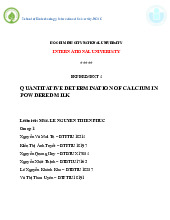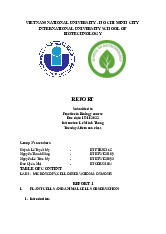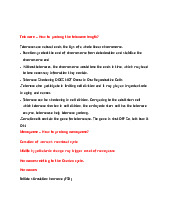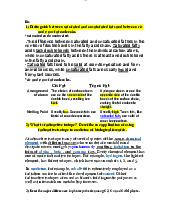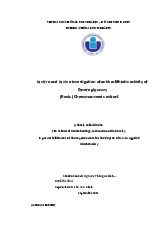





Preview text:
l OM oARc PSD|36 49 0 63 2 Bio
1) Distinguish between saturated and unsaturated fats and between cis and trans fat molecules.
*saturated and unsaturated:
-The difference between saturated and unsaturated fat lies in the number of double bonds
in the fatty acid chain. Saturated fatty acids lack double bonds between the individual
carbon atoms, while in unsaturated fatty acids there is at least one double bond in the fatty acid chain.
- Saturated fats tend to be solid at room temperature and from animal sources, while
unsaturated fats are usually liquid and from plant sources. *cis and trans fat molecules. Cis Fat Trans Fat
Arrangement The chains of carbon atoms are Hydrogen atoms are on the
of atoms on the same side of the double opposite side of the double bond, resulting in a kink. bonds of the carbon chain,
making the fat molecule straight.
Melting Point Usually low. Some cis fats are
Usually high. Trans fats, like liquid at room temperature.
saturated fats ᄃ, are solid at room temperature.
2) What is radioactive isotope? Describe one application of using radioactive isotope in
medicine or biological research.
A radioactive isotope is any of several species of the same chemical element with
different masses whose nuclei are unstable and dissipate excess energy by spontaneously
emitting radiation in the form of alpha , beta , and gamma rays. Every chemical
element has one or more radioactive isotopes. For example, hydrogen, the lightest
element, has three isotopes, which have mass numbers 1, 2, and 3.
In medicine, for example, cobalt-60 is extensively employed as a radiation source to
arrest the development of cancer. Other radioactive isotopes are used as tracers for
diagnostic purposes as well as in research on metabolic processes.
3) Describe major differences in photosynthesis among C3, C4 and CAM plants.
C3 photosynthesis produces a three-carbon compound via the Calvin cycle while C4
photosynthesis makes an intermediate four-carbon compound that splits into a
threecarbon compound for the Calvin cycle. Plants that use CAM photosynthesis gather
sunlight during the day and fix carbon dioxide molecules at night. Type
Seperation in initial CO2 Stom Best l OM oARc PSD|36 49 0 63 2 ata
fixation and Calvin cycle open adapted to Cool, wet environmen C3 No separation Day ts Hot, sunny Between mesophyll and environmen bundle-sheath cells (in C4 space) Day ts Very hot, dry environmen Between night and day (in CAM time) Night ts
4) Name the three stages of cellular respiration; for each, state the region of the
eukaryotic cell where it occurs and the products that result.
There are three main stages of cellular respiration: glycolysis, the citric acid cycle, and
electron transport/oxidative phosphorylation. 1. Glycolysis
Glycolysis occurs in the cytoplasm of cells, outside of mitochondria
Products: The 2 pyruvic acids , net gain of 2 ATP (2 are invested to split the glucose,
and 4 are formed from ADP and P) , 2 NADH, 2ADP
2. the citric acid cycle
occurs in the matrix of the mitochondria
Product: 2ATP, 4CO2, 2FADH2, 6NADH
3. Electron Transport Chain the inner membrane of the mitochondria Product: 34 ATP, 6H2O
Glycolysis occurs in the cytosol producing (for 1 Glucose) 2 pyruvate + 2 NADH + 2 l OM oARc PSD|36 49 0 63 2 ATP
Citric Acid Cycle occurs in the matric of the mittochondira where it produces (for 1
pyruvate): 4 NADH, 1 FADH2, 1 ATP, 3 CO2
Oxidative phosphorylation also occurs in the matrix of the mittochondira producing
1 NADH --> 1 NAD+ + 1/2 H2O + 2.5-3 ATP
1 FADH2 --> 1 FAD + 1/2 H2O + 1.5-2 ATP
5. Describe the fluid mosaic model of cellular structure.
• The plasma membrane, also known as the cell surface membrane or
plasmalemma, defines the boundary of the cell.
• They are a special type of membranes which are lipid structures that separate the cell from its environment.
• In composition, it is a phospholipid bilayer with embedded proteins that enclosing every living cell.
• It serves some specific functions such as controlling the flow of nutrients and ions
into and out of the cells, mediating the response of a cell to external stimuli (a
process called signal transduction), and interacting with bordering cells.
The fluid mosaic model describes the structure of the plasma membrane as a mosaic of
components —including phospholipids, cholesterol, proteins, and carbohydrates—that
gives the membrane a fluid character.
6. What is epigenetic Inheritance? Explain how histone acetylation affect chromatin
structure and the regulation of transcription? l OM oARc PSD|36 49 0 63 2
epigenetic Inheritance : An inheritance pattern in which a modification to a gene or
chromosome alters gene expression in an organism, but the expression is not changed
permanently over the course of generations histone acetylation
Chemical modifications to histones play a direct role in the regulation of gene transcription.
The N-terminus of each histone molecule in a nucleosome protrudes outward from the nucleosome.
These histone tails are accessible to various modifying enzymes, which catalyze the
addition or removal of specific chemical groups.
In histone acetylation, acetyl groups (—COCH3) are attached to positively charged lysines in histone tails
Deacetylation is the removal of acetyl groups.
When the histone tails of a nucleosome are acetylated, their positive charges are
neutralized and they no longer bind to neighboring nucleosomes
Histone acetylation enzymes may promote the initiation of transcription not only by
modifying chromatin structure, but also by binding to, and "recruiting," components of the transcription machinery.
Acetylation enzymes may promote the initiation of transcription via binding and
recruiting components of transcription.
7. Distinguish between the following pairs of terms: dominant and recessive;
heterozygous and homozygous; genotype and phenotype
Dominant: determines organism's appearance
Recessive: has no noticeable effect on appearance
Homozygous: pair of identical alleles
Heterozygous: pair of different alleles Genotype: genetic makeup
Phenotype: appearance or observable traits l OM oARc PSD|36 49 0 63 2
8.Describe meiosis process and explain how this process contributes to genetic variation in species. Interphase
Replication of DNA in preparation for meiosis. After
replication, each chromosome becomes a structure comprising 2 identical chromatids. Prophase I
The chromosomes condense into visible X shaped structures
that can be easily seen under a microscope, and homologous
chromosomes pair up. Recombination occurs as homologous chromosomes exchange DNA.
At the end of this phase, the nuclear membrane dissolves. Metaphase I
Paired chromosomes line up along the middle of the cell. Anaphase I
The pairs of chromosomes separate and move to opposing
poles. Either one of each pair can go to either pole. Telophase I
Nuclear membranes reform. Cell divides and 2 daughter cells are formed. Prophase II
There are now 2 cells. DNA does not replicate again. Metaphase II
Individual chromosomes line up along the middle of the cell. Anaphase II
The chromosome copies (chromatids) separate and move to opposing poles. Telophase II
Nuclear membranes reform. There are 4 new haploid daughter
cells. In males, 4 sperm cells are produced. In females, 1 egg
cell and 3 polar bodies are produced. Polar bodies do not function as sex cells.
During fertilisation, 1 gamete from each parent combines to form a zygote. Because of
recombination and independent assortment in meiosis, each gamete contains a different
set of DNA. This produces a unique combination of genes in the resulting zygote.
Recombination or crossing over occurs during prophase I. Homologous chromosomes – 1
inherited from each parent – pair along their lengths, gene by gene. Breaks occur along
the chromosomes, and they rejoin, trading some of their genes. The chromosomes now
have genes in a unique combination.
Independent assortment is the process where the chromosomes move randomly to
separate poles during meiosis. A gamete will end up with 23 chromosomes after meiosis, l OM oARc PSD|36 49 0 63 2
but independent assortment means that each gamete will have 1 of many different combinations of chromosomes.
